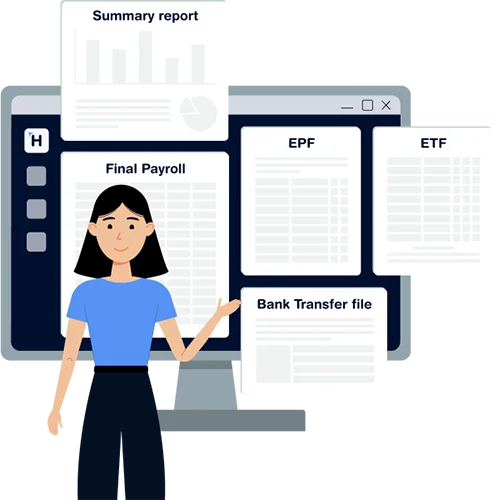Payroll management is a way of compensating employees for the services they have provided to the business. In 2020, the Internal Revenue Service, responsible for collecting taxes in the United States of America, nearly calculated 31.4 billion USD in civil penalties from businesses that haven’t complied with employment tax requirements. Similarly, most businesses have trouble managing their payroll effectively in Sri Lanka, leading to costly fines, inaccurate paychecks, salary delays, etc., which is why this blog will help you learn 8 ways of managing payroll effectively.
1. Make the whole HR team attend payroll training
Although processing payroll is a part of the HR team’s professional training, their skills and expertise are mainly based on recruiting employees and employee records management. However, to manage payroll more effectively in your business, it’s better to involve the entire HR team in payroll training sessions.
Following are the benefits of providing payroll training to the HR team:
- Enhances cooperation between the payroll and HR teams. Since many payroll problems are related to HR, both teams can share their knowledge and expertise to develop better solutions.
- Creates harmony between payroll and HR teams where the HR team will be more sensitive towards the time devoted to payroll processing if they understand the hectic procedures that the payroll team needs to follow.
- Prevents misunderstandings – payroll training will clear all the misunderstandings between the two teams and provide more clarity on payroll policies to the HR team.
Few ways how to carry out payroll training:
- Payroll certification programs through Udemy and Quickbooks Certification Program and Training.
- Excel training skills since calculations are done through excel.
- YouTube videos on payroll management.
2. Stay updated with national tax procedures
Employers and employees need to stay updated and comply with their tax obligations. Many changes can happen in the business, leading to different employee payroll calculations. Some of these changes are business relocation and employee relocation etc. Therefore, when this happens, the employer must collect and update the necessary information to correctly compute payroll and taxes.
Taxes such as EPF, ETF, APIT, stamp duty and gratuity must be adhered to and paid on time.
3. Automate payroll process
Processing payroll is time-consuming and consumes a lot of money, and when payroll is processed manually, it can easily attract mistakes that can result in severe penalties. This is problematic for a growing business that has an increasing number of employees. In addition, payroll processing can become challenging when the HR and payroll staff are limited. Therefore, automating the payroll process through payroll software is the easiest way of ensuring time-consuming tasks are completed on time.
Please read our blog on the different payroll software to select the best one to meet your payroll requirements.
4. Ensure transparency in the payroll process
According to CNBC, 63% of employees prefer working at a company that transparently discloses their pay information over one that does not. Most of the time, problems arise due to employees being unable to figure out how the payroll process works or because the company isn’t transparent about its payroll process. Many payroll issues such as inaccurate salary payments, underpaid taxes, and salary calculations can be resolved if a transparent payroll policy is followed.
A transparent payroll policy should include:
- How the payroll process functions.
- How employees are classified (independent contractor or employee)
- How salaries are calculated.
- Company process in handling payroll errors.
You need to display the policy widely around the company and ensure that each employee has a copy of the payroll policy.
5. Adopt a time and attendance software
Accuracy is vital for payroll processing, and it all starts with accurately monitoring employee attendance. Manually entering employee time in and time out may not be the wisest option in calculating payroll accurately. Even the slightest error in calculating attendance can cause a lousy reputation for the business and poor feedback of the company by the employee. Therefore, having time and attendance software will save time, increase efficiency and improve the productivity of the payroll team, which finally generates accurate payroll reports and payslips.
6. Audit the payroll process
If your company is getting frequent complaints about the payroll calculations, it’s high time to conduct a regular audit of the payroll process. This can be widely seen in companies that still use a manual time card system as they are exposed to great chances of discrepancies.
Following are the steps that need to be followed to ensure an adequate audit is undertaken for the payroll process:
- Test plugins and add-ons to check if the payroll software is integrated correctly with the time and attendance system.
- Implement a biometric system which automatically records the time an employee signs in for work.
Meanwhile, you should ensure that your employees understand their role in the payroll process to ensure salary calculations are accurate based on their attendance. For example, using their timecard correctly and on time to work and when leaving work.
7. Hire a qualified payroll team
The payroll team should handle their job requirements, or they end up making errors, incur costly compliance penalties and, in the end, face job dissatisfaction. It’s, therefore, essential for the company to hire a candidate that best fits the job requirements. At the same time, a payroll member’s experience and adaptability are crucial qualities.
8. Gain feedback about the payroll procedures from employees
It’s a mistake to assume that all your employees understand the company’s payroll procedures. You need to ask your employees and gain feedback on how they feel the current payroll procedure is. These communications will help you identify the areas of misunderstanding on time and leave attendance records, pay slips, salary calculations, etc.
You can start by having a meeting with all the employees. It would help if you asked which payroll processes work best for them and which areas need improvement. It’s also best to have a survey to determine employee satisfaction with the current payroll procedures.
Conclusion
We hope that this blog has given you a comprehensive understanding of the ways of managing payroll effectively and would be helpful to your company’s payroll management.
Resources
https://fitsmallbusiness.com/tips-for-managing-payroll/

